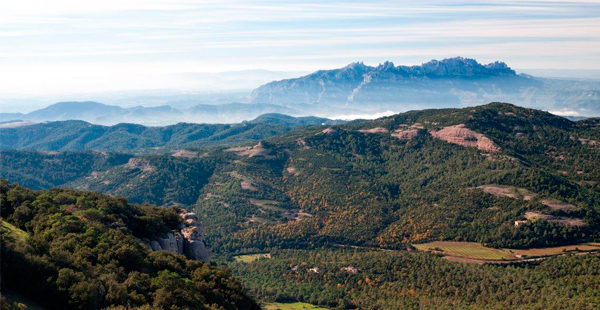Physical features:
Montseny, sanding out between the plains of Vallès, Osona and La Selva, is a mountainous block with a characteristic profile, steep and visible from many places in Catalonia and well known for the beauty of its landscapes. The special land orography, altitude differences and distance from the sea together with typical Mediterranean latitude conditions generate a remarkable climatic diversity. Generally speaking, it can be said that, as height is gained, the climate changes from a Mediterranean to a cold mountain one, with different intermediate stages that vary depending on the orientation of the slopes.
Vegetation:
Differences in humidity and temperature explain the vegetation that is taking place in Montseny. Placed in layers, while gaining altitude it is possible to find typical Mediterranean vegetation in the lower parts (holm oaks, cork oaks and pine groves), rainy mid-mountain vegetation at medium levels (mountain peaks and oak groves), Central European environments above 1,000 m (beech and spruce) and even subalpine environments at peaks (scrub and culmination meadows). The confluence of these factors in an abrupt relief made up of streams and cliffs produces an extraordinary variety of habitats. Different relict species find in Montseny the last corner where to settle, which gives a high ecological value to these areas, with the presence of remarkable endemisms.
Wildlife:
Montseny is a refuge for many species typical from more latitude habitats (Central European), which find in the massif, the southern limit of its distribution in Catalonia. The wooded character of Montseny largely determines the fauna that inhabits it. In the holm oak, there is wild boar, fox, genet and garden dormouse among the best-known mammals; goshawk, Eurasian jay and Robin among the most common birds, and several species of amphibians, reptiles and fishes. The most unique species in the park is the Montseny brook newt, discovered a few years ago and the only endemic vertebrate of the massif.
Human settlement and heritage:
The first evidences of settlement in Montseny date from the Paleolithic, as evidenced by several findings in the Breda stream, Congost, Brull, Montseny and Sant Marçal. There are also megaliths from the Neolithic era in the Arca mountain range and les Pinedes, among others. In the Iberian period settlements began in the surroundings of the massif and some hills started to be permanently occupied with fortifications such as the walls of the Montgròs hill, in the municipality of El Brull, and the different fortified settlements: Montclús in Sant Esteve de Palautordera, Can Flequer in Samalús and la Mora tour in Sant Feliu de Buixalleu.
Some constructions are from the Roman period such as the Roman villa of Can Tarrés (La Garriga) and others on the neighboring plains, following the Via Augusta and Via Ausa. It is not until the Middle Ages that scattered settlements are widespread and the exploitation of natural resources is intensified. Many of the existing farmhouses date from this period. This process reached its maximum splendor in the nineteenth century, when a slow depopulation began. Currently, the regression of agricultural, forestry and livestock activities has led to a change in family economies. Other activities, mainly services, such as rural tourism, catering and accommodation, complement family income and coexist with the extensive peasant culture of the area. The Middle Ages are well represented by Romanesque examples of religious architecture with more than a dozen small mountain temples. The church with pre-Romanesque paintings of Sant Pere Desplà (Arbúcies), as well as the parochial churches of Montseny and El Brull, or those of La Mora, Sant Marçal, Sant Cristòfol de la Castanya, Sant Martí de Montseny, Aiguafreda de Dalt and Sant Cristòfol de Cerdans. Also important are the remains of military buildings, such as the castles of Montsoriu (the most important example of Gothic military architecture in the country, X-XIV centuries), Montclús, Fluvià, Brull and Cruïlles and the fortified farmhouses of Bellver and la Sala. There are also architectural ensembles such as the one of Tagamanent, with constructions of the Romanesque and Gothic periods, and the one of Sant Segimon, an important hermitage of the 17th century.








